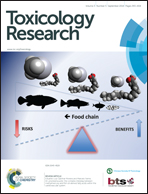Cytotoxic study of three derivatives amidophosphonates on alternative cellular model: Paramecium tetraurelia
Abstract
The toxicological impacts of the increasing number of synthetic compounds present in the aquatic environment are assessed predominantly in laboratory studies where test organisms are exposed to a range of compounds. Protozoan cells are often used as bioindicators for the presence of xenobiotics. In this work, we study the cytotoxicity of three newly synthesized amidophosphonates (AP1, AP2, and AP3) on an alternative cellular model: the protist ciliate Paramecium tetraurelia. We also used an analogue marketed in Algeria for comparison: chlorpyriphos ethyl. The LC50 values were determined for these protozoa after a series of preliminary toxicity tests and used for the rest of our study: 30 μM for AP1, AP2 for 25 μM, 15 μM for AP3, and 10 μM for chlorpyriphos ethyl. The growth kinetics of the protozoa are perturbed and this is confirmed by the percentage of response, and we also demonstrated a significant decrease in GSH thus confirming the toxicity of the tested compounds. According to the results of our study, it has been proven that amidophosphonates AP1, AP2, AP3 show less cytotoxic effects than chlorpyriphos ethyl.


 Please wait while we load your content...
Please wait while we load your content...